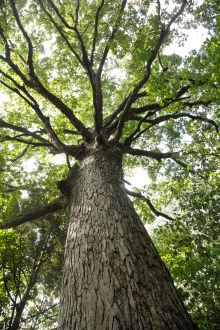
Conserving the White Oak Tree: Critical for timber and distilling industries
A group of researchers from the University of Kentucky, The University of Tennessee and Indiana University, including those supported by the U.S. National Science Foundation, have collaborated with scientists from the U.S. Forest Service and others to produce the first complete genome for the white oak (Quercus alba), a tree that provides large amounts of timber and is the primary species used in barrels for aging spirits.

Credit: Matthew Barton, University of Kentucky
Data to complete the genome came from a range of academic sources, the Forest Service, state forest services and industry. By combining those data into an unbiased annotation of the white oak's genes, the researchers have created a resource to understand genetic diversity and population differentiation within the species, assess disease resistance and the evolution of genes that enhance it, and compare with other oak genomes to determine evolutionary relationships between species and how the genomes have evolved.
"Plants, including trees, help meet society's needs for food, fuel, fiber and, in this case, other key economic services. Having genomic data like this helps us address important biological questions, including those related to the economic and societal use of the species," said Diane Jofuku Okamuro, a program officer in the NSF Directorate for Biological Sciences.
The research was led by Meg Staton, associate professor at The University of Tennessee, and Drew Larson, NSF postdoctoral fellow at Indiana University, and coordinated by Seth DeBolt, University of Kentucky, and Dana Nelson, U.S. Forest Service Southern Research Station.
The work, which was also supported by Makers Mark, Independent Stave Company and Suntory Global Spirits, was published in New Phytologist.
Distribution channels: Science
Legal Disclaimer:
EIN Presswire provides this news content "as is" without warranty of any kind. We do not accept any responsibility or liability for the accuracy, content, images, videos, licenses, completeness, legality, or reliability of the information contained in this article. If you have any complaints or copyright issues related to this article, kindly contact the author above.
Submit your press release